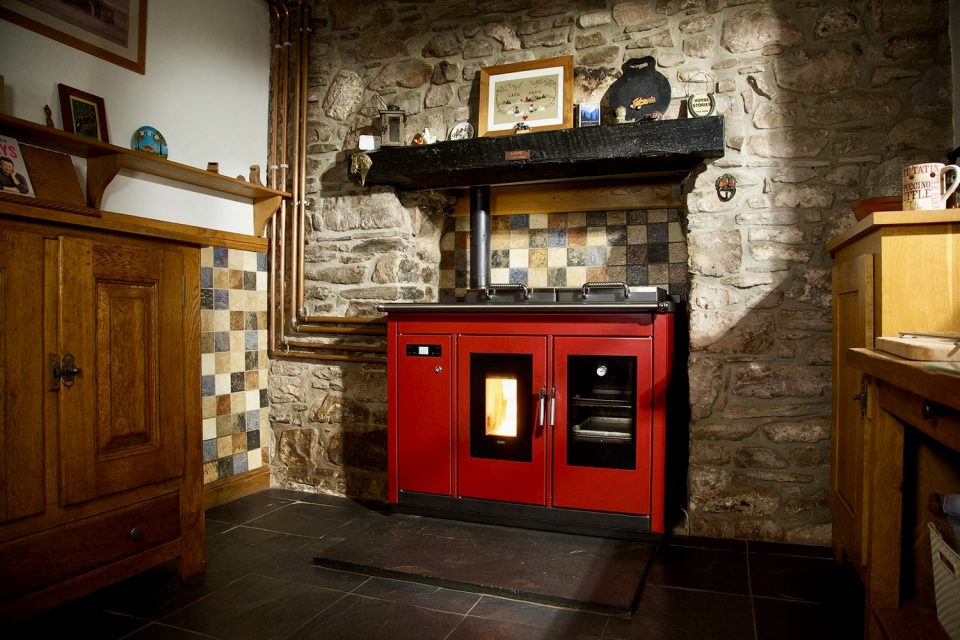Switching rural homes to renewable heating offers significantly greater carbon savings compared to townhouses. Despite this potential, it remains an underutilised opportunity.
Rural homes often suffer from poorer insulation, tend to be detached, and are harder to insulate, leading to higher heat consumption. These homes are typically heated by oil, which has far higher CO2 emissions per kWh compared to gas – about 42% higher. In contrast, townhouses are usually heated by gas, a less carbon-intensive fuel.
To illustrate, let’s consider two hypothetical homes near Birmingham: a terraced townhouse on the gas network and a detached, stone-walled rural cottage with a single-phase electricity supply, heated by oil.
Townhouse:
- Peak heat load: 8kW
- Yearly consumption: 11,600kWh
- CO2 per kWh of gas: 0.21 kg
- Boiler efficiency: 85%
- Annual CO2 emissions: 2.87 tonnes
Cottage:
- Peak heat load: 20kW
- Yearly consumption: 34,380kWh
- CO2 per kWh of oil: 0.298 kg
- Boiler efficiency: 85%
- Annual CO2 emissions: 12.06 tonnes
Switching both homes to renewable heating systems through the Boiler Upgrade Scheme (BUS) grant, the townhouse owner installs a heat pump, while the cottage owner replaces the oil boiler with a wood pellet boiler.
Renewable Heating System Assumptions:
- CO2 per kWh for electricity: 0.136 kg
- CO2 per kWh for wood pellets: 0.053 kg
- Heat pump efficiency: 3.5 (for every kWh of electricity used, 3.5 kWh of heat is produced)
- CO2 per kWh for heat pump: 0.038 kg
Revised CO2 emissions:
Townhouse:
- Annual CO2 emissions: 0.44 tonnes
- Annual CO2 savings: 2.43 tonnes
- 15-year CO2 savings: 36.45 tonnes
Cottage:
- Boiler efficiency: 85%
- Annual CO2 emissions: 2.1 tonnes
- Annual CO2 savings: 10 tonnes
- 15-year CO2 savings: 150 tonnes
Value for Money in CO2 Reduction
Analysing the cost-effectiveness of CO2 emissions reduction:
Townhouse:
- BUS grant: £7,500
- Cost per tonne of CO2 avoided: £205
Cottage:
- BUS grant: £5,000
- Cost per tonne of CO2 avoided: £33
If the cottage received the same £7,500 grant, the cost per tonne of CO2 avoided would be £50. Even so, switching the cottage to renewable heating is six times more cost-effective in terms of carbon savings, at just 16% of the cost per tonne of CO2 avoided for the townhouse.
Policy Implications
The current Boiler Upgrade Scheme disadvantages rural homeowners, who stand to achieve the highest carbon reductions, by offering them £2,500 less than those installing heat pumps. This disparity represents a missed opportunity.
Increasing the grant to £7,500 for all homes would make economic sense, as the rural cottage example demonstrates. Even at this higher grant level, the cottage remains a cost-effective solution, achieving over four times the carbon savings per grant-pound compared to the townhouse.
Expanding support for renewable heating in rural areas would unlock substantial carbon savings and enhance the value for money of public investment in carbon reduction.

